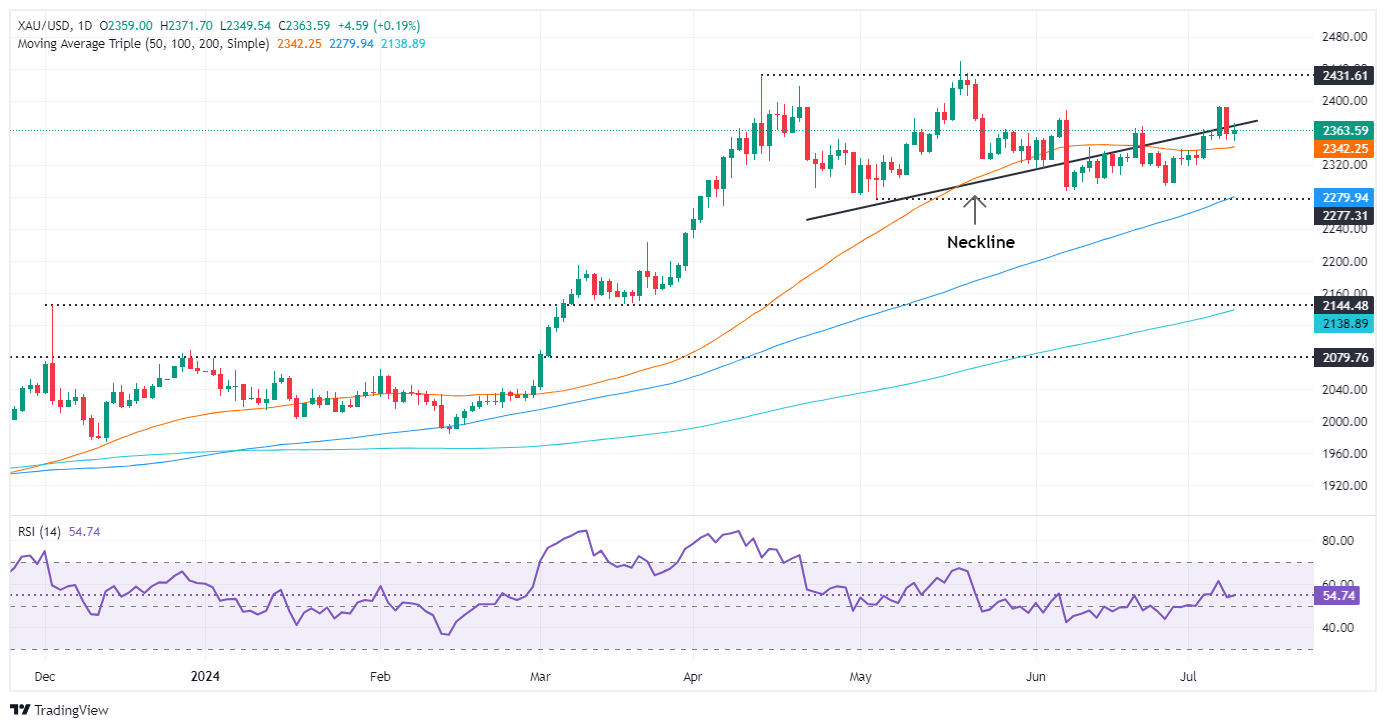Gold price stays firm ahead of US inflation data
- Gold prices rise above $2,360 after Powell’s Senate testimony indicates a cautious approach to rate cuts.
- US 10-year Treasury yield edges up to 4.296%, while DXY gains 0.14%.
- World Gold Council reports second month of ETF inflows, contrasting with PBoC’s pause in Gold purchases.

Gold prices edged up during Tuesday’s North American session after Federal Reserve Chair Jerome Powell appeared at the US Senate Banking Committee and stated that inflation is moving toward the Fed’s 2% goal, yet it is not ready to lower borrowing costs. The XAU/USD trades at $2,364, gaining more than 0.25%.
The golden metal recovered slightly amid elevated US Treasury bond yields and a firm US Dollar. The US 10-year benchmark note coupon climbs one-and-a-half basis points (bps) to 4.296%, while the US Dollar Index (DXY) trends steadily above the 105.00 mark, gaining 0.14%.
Fed Chair Powell stated that “elevated inflation is not the only risk we face,” warning that lowering interest rates too little or too soon could put the economy at risk. He added that while it’s possible to hike rates if the data supports it, the most likely direction would be to “begin to loosen policy at the right moment."
Aside from this, the World Gold Council (WGC) revealed that Gold exchange-traded funds (ETFs) experienced a second month of inflows in June. The WGC stated that total fund holdings rose by around 18 tonnes to 3,106 tonnes.
This contrasts with the People’s Bank of China’s (PBoC) decision not to buy Gold in June as it did in May. China held 72.80 million troy ounces of the precious metal at the end of June.
The US economic docket during the week will feature Powell’s speech at the US House of Representatives on Wednesday, followed by the release of inflation figures on the consumer and producer sides. Initial Jobless Claims and the University of Michigan Consumer Sentiment will complement the schedule.
Daily digest market movers: Gold price advances during Powell’s speech
- US CPI is expected to decrease from 3.3% to 3.1% YoY in June, while core inflation is projected to remain steady at 3.4% YoY.
- According to the consensus, Initial Jobless Claims for the week ending July 6 are expected to increase from 238K to 240K.
- July Consumer Sentiment is set to improve to 68.5, up from 68.2 in June, according to the consensus.
- Federal Open Market Committee (FOMC) June Meeting Minutes revealed that most participants believe the current policy is restrictive but are open to further rate increases. Policymakers acknowledged that the economy is cooling and could respond to unexpected economic weaknesses.
- According to data from the CME FedWatch Tool, investors are pricing in 70% odds of a Fed rate cut in September, up from 73% on Monday.
- December 2024 fed funds rate futures contract implies that the Fed will ease policy by 39 basis points (bps) toward the end of the year.
Technical analysis: Gold price hovers around Head-and-Shoulders neckline
Gold price formed a bearish Harami candlestick pattern after breaching the Head-and-Shoulders neckline, which pushed XAU/USD toward the $2,400 figure before tumbling to the current price level.
Buyers are still in charge with the Relative Strength Index (RSI) standing in bullish territory above the 50-neutral line.
Therefore, Gold’s first resistance would be the July 5 high at $2,392, followed by the $2,400 figure. Further upside is seen, with the next resistance lying at the year-to-date high of $2,450, ahead of the $2,500 mark.
Conversely, if XAU/USD slumps below $2,350, the golden metal might decline to the $2,300 level. If this support fails, the next demand zone would be the May 3 low of $2,277, followed by the March 21 high of $2,222.
Gold FAQs
Gold has played a key role in human’s history as it has been widely used as a store of value and medium of exchange. Currently, apart from its shine and usage for jewelry, the precious metal is widely seen as a safe-haven asset, meaning that it is considered a good investment during turbulent times. Gold is also widely seen as a hedge against inflation and against depreciating currencies as it doesn’t rely on any specific issuer or government.
Central banks are the biggest Gold holders. In their aim to support their currencies in turbulent times, central banks tend to diversify their reserves and buy Gold to improve the perceived strength of the economy and the currency. High Gold reserves can be a source of trust for a country’s solvency. Central banks added 1,136 tonnes of Gold worth around $70 billion to their reserves in 2022, according to data from the World Gold Council. This is the highest yearly purchase since records began. Central banks from emerging economies such as China, India and Turkey are quickly increasing their Gold reserves.
Gold has an inverse correlation with the US Dollar and US Treasuries, which are both major reserve and safe-haven assets. When the Dollar depreciates, Gold tends to rise, enabling investors and central banks to diversify their assets in turbulent times. Gold is also inversely correlated with risk assets. A rally in the stock market tends to weaken Gold price, while sell-offs in riskier markets tend to favor the precious metal.
The price can move due to a wide range of factors. Geopolitical instability or fears of a deep recession can quickly make Gold price escalate due to its safe-haven status. As a yield-less asset, Gold tends to rise with lower interest rates, while higher cost of money usually weighs down on the yellow metal. Still, most moves depend on how the US Dollar (USD) behaves as the asset is priced in dollars (XAU/USD). A strong Dollar tends to keep the price of Gold controlled, whereas a weaker Dollar is likely to push Gold prices up.
Author

Christian Borjon Valencia
FXStreet
Christian Borjon began his career as a retail trader in 2010, mainly focused on technical analysis and strategies around it. He started as a swing trader, as he used to work in another industry unrelated to the financial markets.


















